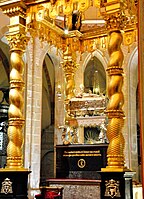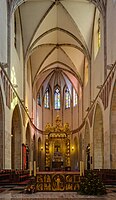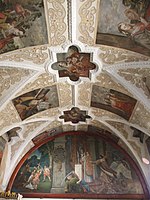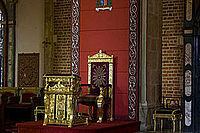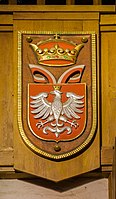Gniezno Cathedral
This article includes a list of general references, but it lacks sufficient corresponding inline citations. (September 2022) |
| Primatial Basilica Metropolitan Cathedral of Gniezno | |
|---|---|
Archdiocese of Gniezno | |
Historic Monument of Poland | |
| Designated | 1994-09-08 |
| Reference no. | M.P. z 1994 r. Nr 50, poz. 416[1] |
The Royal Gniezno Cathedral (The Primatial Cathedral Basilica of the Assumption of the Blessed Virgin Mary and Shrine of St. Adalbert,
The cathedral is known for its twelfth-century (ca. 1175), two-winged
The temple is one of Poland's national
History
Early history
The religious temple dates back to the end of the ninth century, when an oratory was built in the shape of a rectangular nave. At the end of the tenth century Duke
In March 1000 Emperor
In the year 1025 Bolesław the Brave was crowned as the first King of Poland in the Gniezno Cathedral. After his death
Late Middle Ages
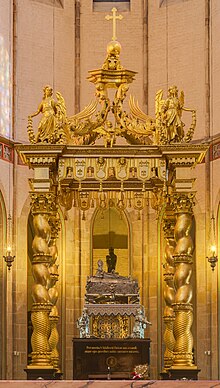
In the years 1103–1104 a synod was held with the participation of the papal legate associated with the retrieval and placing of the precious relics of St. Adalbert in the cathedral. A few years later, Duke
After 219 years, in 1295, the penultimate royal coronation of Prince
In 1613 a fire destroyed the spires, roof and two frontal towers of the temple. Seven years later,
Modern period
In 1809, the French army installed a military warehouse in the cathedral which was removed when Napoleon's troops left the area. In 1931, Pope Pius XI bestowed the title of minor basilica on the cathedral. In 1939, following the invasion of Poland, the Nazis converted the temple into a concert hall. In 1945, another fire broke out which was caused by the intentional incendiary artillery shelling by the Red Army. This partially ruined the Gothic vault and consequently also the pipe organs and other historical architectural details. The city was retaken by the Soviets without any resistance offered by the Germans. At the turn of the 1950s and 1960s, the temple was fully restored in the Gothic style and all baroque architectural elements were subsequently removed from the nave and the temple itself, giving it a more medieval look to specifically resemble the original structure present during the coronation of Polish monarchs eight hundred years earlier.
On 3 June 1979 Pope John Paul II visited the cathedral.
Architecture
Chapels

The elliptical cupola covering the late-baroque Potocki Chapel, designed by
The 14th-century Kołudzki Chapel was renovated in 1647 with consistent interior furnishings. The four corners of the world are personified on the mid-18th-century polychrome vault. The early-baroque portal with its 17th-century renaissance grille from Gdańsk is one of Poland's greatest blacksmithing achievements. The foundation plaque of the chapel has Szymon Kołudzki's (d. 1656), portrait, epitaph and tombstone.[7]
St. Nicholas Chapel, also known as Dzierzgowski Chapel, dates from the 14th century. The Gothic arcade has the remains of 14th-century Gothic sculptural ornamentation featuring hunting scenes engraved in artificial stone and a mid-16th century renaissance polychrome. The chapel is embellished with two precious renaissance tombstones: the first was sculpted from red marble by Bartolommeo Berecci and features the reclining figure of Abp. Andrzej Krzycki (d. 1573), humanist and politician; the second was for Abp. Mikołaj Dzierzgowski (d. 1559), a supporter of Queen Bona Sforza, and was sculpted from sandstone and red marble by Hieronim Canavesi. There is also a round tondo with the Madonna of Giovanni Maria Padovano in the copestone.[8]
The Łubieński Chapel was created in 1642–1648 by joining two medieval chapels and restructured along early-classicist lines in 1778. The early-baroque portals from c. 1640 are made of marble and closed with renaissance grilles from Gdańsk. The early-baroque tomb of Archbishop Maciej Łubieński (d. 1652) is made of marble and alabaster. The altar painting from 1646 has portraits of Łubieński family members.[9]
Interior
The cathedral is a three-nave basilica-looking structure with polygonal presbytery and ambulatory and many adjacent chapels of noble and aristocratic families, some personally funded by the head of the family or the monarch of Poland. Under the tiled floor several discoveries were made; these included the relics of earlier pre-Romanesque buildings and several tombs of former archbishops. In the crypt of the cathedral there is a 1006-year-old sepulchral stone inscription on display, the oldest of its kind in the country, discovered by archeologists. Other aspects of the crypt may include the remaining fragments of the walls of the first temple funded by Mieszko I of Poland.
In the center of presbytery of the cathedral stands the golden baldachin (based on the
Royal coronations in the cathedral
- 18 April 1025 – Bolesław I the Brave
- 25 December 1025 – Richensa of Lotharingia
- 25 December 1076 – Kiev
- 26 June 1295 – Przemysł II and his wife Margaret of Brandenburgia
- August 1300 – Wenceslaus II of Bohemia
See also
- Gniezno Doors
- Congress of Gniezno
- Polish Crown Jewels
- Szczerbiec
- Royal coronations in Poland
- Wawel Cathedral
- St. John's Cathedral
- History of early modern period domes
Gallery
-
Coffin of Adalbert of Prague
-
Fresco in the dome of a side chapel
-
View of the interior
-
Stained glass window
-
12th-century Gniezno Doors
-
Pipe organ
-
Rib vault with 17th-century paintings
-
Episcopal throne
-
National coat of arms of Poland within the cathedral
-
Night view with water reflection
Bibliography
- Gabriela Mikołajczyk: Zabytki Katedry Gnieźnieńskiej. Gniezno: Prymasowskie Wydawnictwo „Gaudentinum”, 1992. ISBN 83-85654-01-1.
- Tadeusz Dobrzeniecki: Drzwi Gnieźnieńskie. Kraków: 1953.
- Tomasz Janiak, Z badań nad przestrzenią liturgiczną romańskiej katedry w Gnieźnie, w: Architektura romańska w Polsce. Nowe odkrycia i interpretacje, Materiały z sesji naukowej w MPPP, Gniezno 2009
- Narodowy Instytut Dziedzictwa: Rejestr zabytków nieruchomych – województwo wielkopolskie (pol.). 31 marca 2015. [dostęp 6.05.2010].
- Katedra w Gnieźnie (970–1945). [dostęp 2010-01-14].
- Włodzimierz Łęcki: Gniezno. Poznań: WPT Przemysław, 1980, s. 12–18. ISBN T-17/2322.
- Katedra Gnieźnieńska. [dostęp 2010-01-14].
- Dzieje Polski. [dostęp 2009-08-14].
- M. Rożek Polskie koronacje i korony – wyd. KAW, 1987.
- Katedra Prymasowska w Gnieźnie. [dostęp 2010-01-14].
Online tour
- Aarchidiecezja.pl – Panorama. Archived 2020-07-17 at the Wayback Machine.
References
- ^ Zarządzenie Prezydenta Rzeczypospolitej Polskiej z dnia 8 września 1994 r. w sprawie uznania za pomnik historii., M.P. z 1994 r. Nr 50, poz. 416
- ^ http://isap.sejm.gov.pl/DetailsServlet?id=WMP19940500416. Archived 2014-01-07 at the Wayback Machine
- ^ valuable, priceless, lost Archived 2007-09-27 at the Wayback Machine
- ^ "Gniezno Cathedral in Gniezno – Attractions | Frommer's". app.frommers.com. Archived from the original on 2015-07-13.
- ^ "Gniezno Cathedral in Gniezno – Attractions | Frommer's". app.frommers.com. Archived from the original on 2015-07-13.
- ^ "The Primatial Cathedral Basilica of the Assumption of the Blessed Virgin Mary and St. Wojciech (Adalbert) in Gniezno – Katalog obiektów – Region Wielkopolska – a must see". Archived from the original on 2016-03-05. Retrieved 2015-07-12.
- ^ "The Primatial Cathedral Basilica of the Assumption of the Blessed Virgin Mary and St. Wojciech (Adalbert) in Gniezno – Katalog obiektów – Region Wielkopolska – a must see". Archived from the original on 2016-03-05. Retrieved 2015-07-12.
- ^ "The Primatial Cathedral Basilica of the Assumption of the Blessed Virgin Mary and St. Wojciech (Adalbert) in Gniezno – Katalog obiektów – Region Wielkopolska – a must see". Archived from the original on 2016-03-05. Retrieved 2015-07-12.
- ^ "The Primatial Cathedral Basilica of the Assumption of the Blessed Virgin Mary and St. Wojciech (Adalbert) in Gniezno – Katalog obiektów – Region Wielkopolska – a must see". Archived from the original on 2016-03-05. Retrieved 2015-07-12.

